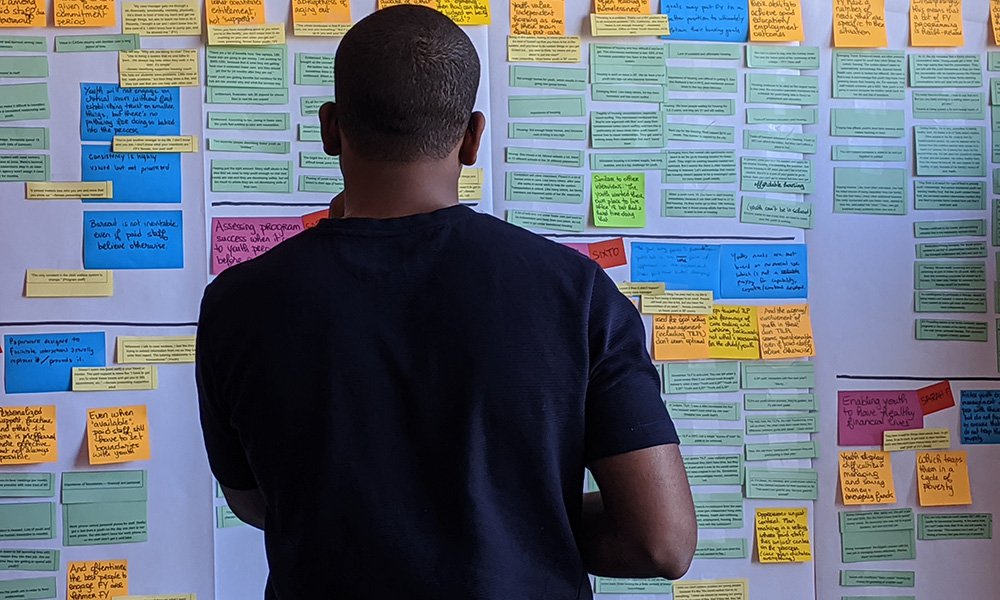The challenge
Across the country, outcomes for young people who’ve been in the foster care system and aged out are universally poor. Compared to the general population, they’re more likely to face homelessness, lower educational attainment, health consequences of trauma, substance abuse, early death, and prison. While the problems within the system are well known, efforts to solve them have been unsuccessful.
To make matters worse, foster care services often end abruptly for teens and young adults. These vulnerable young people—many of whom have been put on medications for anxiety, anger, or depression—find themselves without a support network or access to resources like health care.
Think of Us is a non-profit organization dedicated to leveraging the power of personal experience, technology, and design to improve the lives of youth in foster care. Their team was looking to better understand the transition experience for youth aging out of foster care.
The project
The Think of Us team engaged Bloom Works to talk with youth and staff in 5 partner sites to identify technology interventions that could prepare young people more effectively as they age out of foster care. Our researchers worked closely with the Think of Us team throughout the duration of the project (about 12 weeks in total). We conducted 2 days of interviews with staff and teens at each of the 5 partner sites.
Our research focused on:
- How the foster care system looks to teens and on-the-ground staff
- Where the system is doing well and where it’s falling short
- Specific interventions that could improve the lives of people in foster care, particularly of youth aging out of care
Our analysis of the qualitative data identified 3 opportunity areas for impactful interventions.
Healing and dealing with trauma
All youth in foster care have experienced trauma, since removal from the home—for whatever reason—is traumatic. Young people need a caring, stable, and nurturing environment to recover, but the foster care system often fails to provide that.
Preparing youth for their aging out transition
The current methods for preparing young people to transition from foster care to being independent young adults aren’t working. Teens and staff all spoke of the need for building life skills, like planning for the future and managing money. Even though the system spends a lot of energy on "preparedness," these efforts are often lost in translation to youth. Preparedness needs to be defined and understood by young people themselves. They also called for preparing young people with strong coping skills before they leave the structured foster care system.
Helping youth build a supportive network
The youth we spoke to talked about a dichotomy of relationships with supportive adults—paid adults within the system and other adults outside of the system they keep deliberately isolated in an effort to maintain these relationships. This dichotomy leaves young people without a clear system of support once they exit foster care. They lose access to paid staff, and they’re reluctant to ask for help from others.
The result
The team published a report that represents a key step forward in creating positive change for youth in foster care in the U.S. Through our partnership with youth, staff, and Think of Us, we’ve gained a deeper understanding of what’s happening for youth in the foster care system. And just as importantly, we’ve documented some specific opportunities for meaningful interventions.
Map of the system
We used our interviews to create a journey map documenting how older youth in foster care experience the system and their transition out. The map is a tool that the Think of Us team can use to help build understanding and awareness, diagnose (in systems terms) problem areas more effectively, and give more specific guidance to social service organizations.
How technology could close gaps
We’ve documented several ways in which technology could be used to close current gaps in the system. The young people we spoke with use technology regularly, but not in ways that connect to their care. We’ve outlined potential directions for an app designed for teens and youth that could:
- Increase engagement in their own case management
- Provide them with better access to support for navigating the system
- Bridge the current disconnect between the system’s support network and their external network
As a result of this work, the whole project team has developed a more nuanced understanding of the systemic problems and opportunities within the foster care system. Our next step will be applying this understanding to iterating on how technology can be leveraged to improve the lives—and long-term outcomes—of young people.

